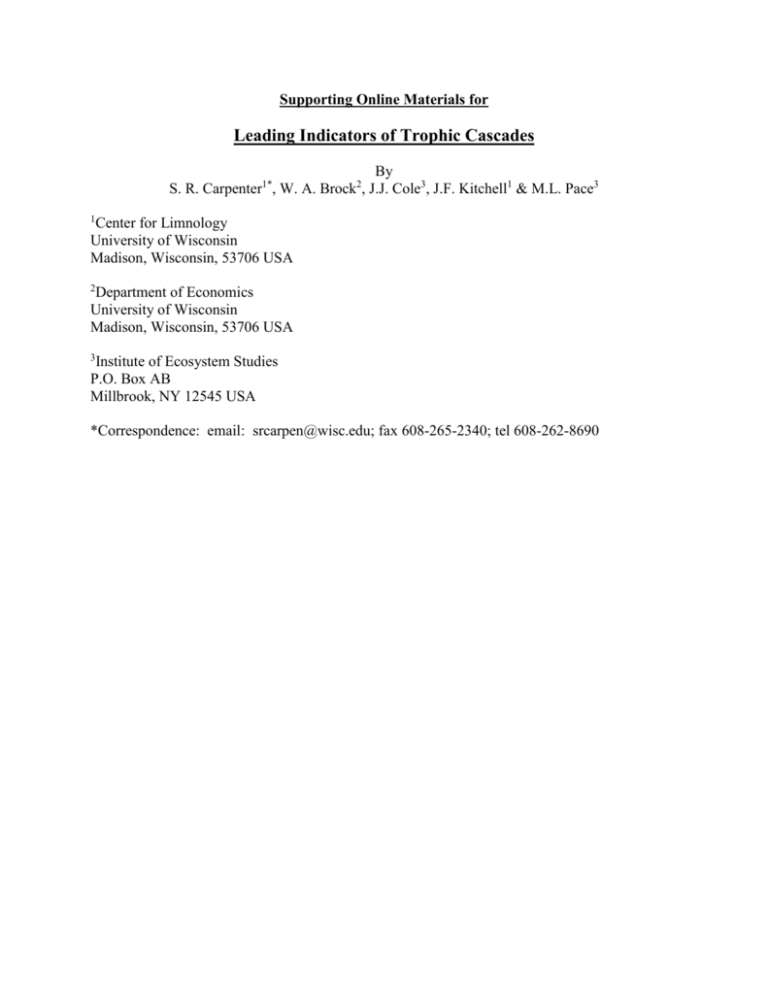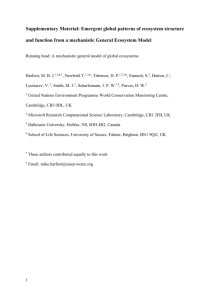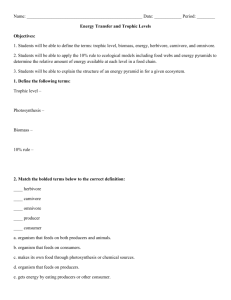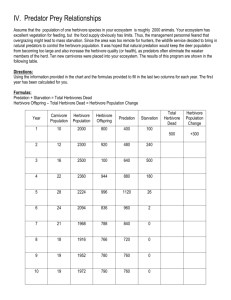ELE_tables1,+sa1,+figss1-s8
advertisement

Supporting Online Materials for Leading Indicators of Trophic Cascades By S. R. Carpenter1*, W. A. Brock2, J.J. Cole3, J.F. Kitchell1 & M.L. Pace3 1 Center for Limnology University of Wisconsin Madison, Wisconsin, 53706 USA 2 Department of Economics University of Wisconsin Madison, Wisconsin, 53706 USA 3 Institute of Ecosystem Studies P.O. Box AB Millbrook, NY 12545 USA *Correspondence: email: srcarpen@wisc.edu; fax 608-265-2340; tel 608-262-8690 SUPPLEMENTARY MATERIAL The following supplementary materials are provided for this manuscript: Table S1. Parameter values used in the simulations. Appendix S1. Estimating the critical point of the deterministic skeleton Figure S1. Histograms from samples of the planktivore stationary distribution at 8 values of qE near the transition point. Figure S2. Histograms from samples of the juvenile piscivore stationary distribution at 8 values of qE near the transition point. Figure S3. Histograms from samples of the herbivore stationary distribution at 8 values of qE near the transition point. Figure S4. Histograms from samples of the phytoplankton stationary distribution at 8 values of qE near the transition point. Figure S5. Variance spectra for herbivore biomass. Figure S6. Variance spectra for planktivore biomass. Figure S7. Standard deviations of the state variables prior to the shift in transient simulations. Figure S8. Return rates of the state variables prior to the shift in transient simulations. Table S1. Parameter values used for the simulations. Symbol value 0.3 units g g-1 F, H, P 0.1 A2biom 0.2 Same as F, H and P, respectively kg/fish interpretation Conversion of consumed phytoplankton phosphorus to zooplankton phosphorus Standard deviation of stochastic process source Fit to data of Carpenter et al. 2001 Convert densities to kg ha- Fit to data of Carpenter et al. 2001 Fit to data of Carpenter et al. 2001 1 cFA 0.3 t-1 A-1 cHF 0.1 t-1 F-1 cJA 0.001 t-1 A-1 cJF 0.5 t-1 F-1 cPH 0.25 t-1 H-1 DF 0.1 t-1 DH 0.5 t-1 DOC 5 G m-3 Consumption coefficient of planktivores by adult piscivores Consumption rate of zooplankton by planktivore Consumption coefficient of juvenile piscivores by adult piscivores Consumption coefficient of juvenile piscivores by planktivores Consumption rate of phytoplankton by zooplankton Diffusion parameter for planktivores Zooplankton diffusion parameter DOC concentration F2biom 1 kg/(500 fish) Convert densities to kg ha1 f 2 Jt+1 / (AtI + JtI) Fo 100 F h 8 t-1 Ho 1 H Fecundity of adult piscivore Refuge density of planktivores Refuging parameter for juvenile piscivores Refuge biomass I0 300 Eins m-2 s-1 Surface irradiance Arbitrary Fit to data of Carpenter et al. 2001 Fit to data of Carpenter et al. 2001 Fit to data of Carpenter et al. 2001 Fit to data of Carpenter et al. 2001 Fit to data of Carpenter et al. 2001 Fit to data of Carpenter et al. 2001 Typical value for our experimental lakes (Carpenter et al. 2001) Fit to data of Carpenter et al. 2001 Fit to data of Carpenter et al. 2001 Fit to data of Carpenter et al. 2001 Fit to data of Carpenter et al. 2001 Fit to data of Carpenter et al. 2001 Typical daily average for summer on Sparkling Lake (NTL-LTER) IZ - Eins m-2 s-1 J2biom 0.05 kg/(10 fish) kDOC kgrow 0.0514 m2 g-1 0.012 (Eins m-2 s-1)1 kinhib 0.004 (Eins m-2 s-1)1 ko 0.0213 m-1 kP 0.0177 m2 mg-1 L 0.6 mg m-2 t-1 m 0.1 t-1 qE varied t-1 rP 3 m2 mg-1 s 0.5 t-1 v 1 t-1 Zmix 4 m irradiance at depth Z (I0 is sometimes a parameter; otherwise IZ is a variable) Convert densities to kg ha1 at the end of a maturation interval light extinction by DOC phytoplankton growth in response to irradiance light inhibition of phytoplankton light extinction by water molecules light extinction by phytoplankton measured as P or chlorophyll (1:1 ratio from Reynolds 1997) Phosphorus load per capita mortality of phytoplankton Harvest rate (catchability times fishing effort) Phytoplankton growth parameter per unit phosphorus load Overwinter survivorship of piscivores Vulnerability parameter for juvenile piscivores Mixed layer depth - Fit to data of Carpenter et al. 2001 Carpenter et al. 1998 Follows et al. 2007 Follows et al. 2007 Carpenter et al. 1998 Carpenter et al. 1998 Approximately twice the baseline value, representing a mildly enriched experimental lake (Carpenter et al. 2001) Follows et al. 2007 Fit to data of Carpenter et al. 2001 Fit to data of Carpenter et al. 2001 Fit to data of Carpenter et al. 2001 Typical value for our experimental lakes (Carpenter et al. 2001) References for Table S1 Carpenter, S.R., J.J. Cole, J.F. Kitchell, and M.L. Pace. 1998. Impact of dissolved organic carbon, phosphorus and grazing on phytoplankton biomass and production in experimental lakes. Limnology and Oceanography 43: 73-80. Carpenter, S.R., J.J. Cole, J.R. Hodgson, J.F. Kitchell, M.L. Pace,D. Bade, K.L. Cottingham, T.E. Essington, J.N. Houser and D.E. Schindler. 2001. Trophic cascades, nutrients and lake productivity: whole-lake experiments. Ecological Monographs 71: 163-186. Dutkiewicz, S., M.J. Follows and P. Parekh. 2005. Interactions of the iron and phosphorus cycles: A three-dimensional model study. Global Biogeochemical Cycles 19, GB 1021. doi: 10.1029/2004GB002342, 2005. Follows, M.J., S. Dutkeiwicz, S. Grant and S.W. Chisholm. 2007. Emergent biogeography of microbial communities in a model ocean. Science 315: 1843-1846. NTL-LTER. Data base of the North Temperate Lakes Long-Term Ecological Research Program. http://lter.limnology.wisc.edu Reynolds, C.S. 1997. Vegetation Processes in the Pelagic: A Model for Ecosystem Theory. Exellence in Ecology Vol. 9, Ecology Institute, Oldendorf/Luhe, Germany. Appendix 1. Estimating the switch point for the piscivores. The deterministic skeleton of the model is the dynamic equations with no added noise. In equations 1, 2, 3, 7 and 8 of the main text, F, H and P were set equal to zero to obtain the deterministic skeleton. The critical points of the deterministic skeleton are useful for interpreting the simulations, even though the deterministic critical points need not correspond to the moments or extrema of the stationary distributions of the stochastic model (Horsthemke and Lefever 1984). Here we report a numerical estimate of the value of qE where the upper steady state for piscivores disappears. The usual procedure for solving for a bifurcation point for a system of equations X(t+1) –X(t) = f[X(t),θ] where θ is scalar and X is an n-dimensional vector is to solve the equation 0 = f[X*( θ), θ] for the steady state X*( θ), assuming it is unique in the domain where we are working. Then calculate the n x n Jacobian matrix f/X and evaluate it at [X*( θ), θ]. Call this J*( θ). Evaluate the n eigenvalues of I+J*( θ) for each θ and find θC such that the largest modulus eigenvalue is on the boundary of the unit circle in the complex plane. See Kuznetsov (1995, Chapter 4) for the details of bifurcation analysis for one-parameter bifurcations in discrete time dynamical systems. Our system can be converted to difference equations where the time step is one maturation interval by the procedure described in the main text. We could conduct a bifurcation analysis by starting at θ qE = 0 where all eigenvalues of the 5 x 5 matrix I+J*( θ) are inside the unit circle, and then gradually increase qE until a value is reached so that the largest value eigenvalue exits the unit circle on the complex plane. However, this is numerical analysis is difficult due to nearsingularity of I+J*( θ) near equilibrium. Therefore, we substituted the following approximate procedure. Our approximate procedure yields an estimate of the value of qE at which the piscivore population collapses. We do not claim that this switch point is the same as a formal bifurcation analysis, but simulations reported in this paper and the numerical analyses shown below indicate that the switch point is very close to the value of qE at which the trophic cascade is triggered in the deterministic skeleton. We focus on the dynamics of A and F. Define (X) Xt+1 – Xt where X is one of the state variables and t to t+1 represents the time between the beginnings of two successive maturation intervals. In the deterministic skeleton, note from equation 6 of the main text that (J(t)) = f s (A(t)) so if A is at equilibrium then J is at equilibrium (i.e. if (A) = 0 then (J) = 0). Also, note that the dynamics of H and P depend on F, but the dynamics of F and A do not depend on H and P. Finally, note that within a maturation interval starting at At the dynamics of A are given by Ai = At exp(-qE i). Thus the dynamics of F within a maturation interval (t < i < t+1) in the deterministic skeleton simplify to dF DF ( FR F ) c FA FAt exp( qE i) di Thus dynamics of F depend only on F, time i within the maturation interval, and constants. Figure S2.1 Rate (A) versus A density. Colors denote values of qE. For these plots, F was set to 1.69, near the solution found numerically in the text of Appendix S2. 20 qE, red to purple:, 1, 1.2, 1.4, 1.6, 1.7, 1.8, 1.9 If we plot (A) versus A (the stock of adult fish), we see a S-shaped curve that crosses (A)=0 three times if qE is small and once if qE is large (Fig. S2.1). These crossing points are equilibria for A. The lower and upper equilibria are stable, and the middle one is unstable. 0 -10 -20 Rate, A(t+1) - A(t) 10 If qE is raised slowly, the S-curve tilts downward on the right. The larger (right hand) stable equilibrium for A becomes smaller and comes closer to the middle, unstable equilibrium value. At a switch point value of qE, the upper equilibrium for A disappears as the S-curve tilts below the line where the y-axis value is zero. 0 50 100 150 200 250 Numerically, these conditions are met by finding the values of qE, A and F (the planktivore) that satisfy the equations A density ( A) 0 [ ( A)] / A 0 [10, 11, 12,] ( F ) 0 Using the box-constrained quasi-Newton method in R, we get the following values for qE, A and F at the switch point: 1.7169, 85.8017, 1.6907. Using the Nelder-Mead method in R, we get 1.7169, 85.7777, 1.6911, essentially the same answer. References for Appendix S2 Horsthemke, W. and R. Lefever. 1984. Noise-Induced Transitions. Springer-Verlag, Berlin. Kuznetsov, Y.A. 1995. Elements of Applied Bifurcation Theory. Springer-Verlag, Berlin. Figure S1. Histograms from samples of the planktivore stationary distribution at 8 values of qE near the transition point. For each histogram, a simulation was initialized near the critical point values of the state variables, run for 10,240 time steps, and then data for the histogram were collected for 2048 time steps. 20 40 60 80 0 60 40 60 0.00 0.3 0.0 20 80 0 20 40 60 Planktivore Population Planktivore, qE = 1.7046 Planktivore, qE = 1.7137 Density 0.3 40 60 80 0 20 40 60 Planktivore Population Planktivore, qE = 1.7069 Planktivore, qE = 1.716 Density 40 Planktivore Population 60 80 80 0.0 0.3 0.6 Planktivore Population 20 80 0.0 0.2 0.4 Planktivore Population 20 80 0.20 Planktivore, qE = 1.7114 Density Planktivore, qE = 1.7023 0.0 0.2 0.4 0 40 Planktivore Population 0.0 Density Density 0 20 Planktivore Population 0.6 0 0.00 Density 0.3 0.0 Density Density 0 0.10 Planktivore, qE = 1.7091 0.6 Planktivore, qE = 1.7 0 20 40 Planktivore Population 60 80 Figure S2. Histograms from samples of the juvenile piscivore stationary distribution at 8 values of qE near the transition point. For each histogram, a simulation was initialized near the critical point values of the state variables, run for 10,240 time steps, and then data for the histogram were collected for 2048 time steps. Density 100 150 0 50 100 150 Juv. Piscivore, qE = 1.7023 Juv. Piscivore, qE = 1.7114 Density 50 100 0.0 0.2 0.4 Juvenile Piscivore Population 0.06 Juvenile Piscivore Population 150 0 50 100 150 Juvenile Piscivore Population Juv. Piscivore, qE = 1.7046 Juv. Piscivore, qE = 1.7137 Density 0.0 0.3 Juvenile Piscivore Population 0.000 0.020 0 50 100 150 0 50 100 150 Juvenile Piscivore Population Juvenile Piscivore Population Juv. Piscivore, qE = 1.7069 Juv. Piscivore, qE = 1.716 0.0 0.00 Density 0.06 0 0.3 Density 50 0.00 Density 0 Density Juv. Piscivore, qE = 1.7091 0.00 0.15 0.04 0.00 Density Juv. Piscivore, qE = 1.7 0 50 100 Juvenile Piscivore Population 150 0 50 100 Juvenile Piscivore Population 150 Figure S3. Histograms from samples of the herbivore stationary distribution at 8 values of qE near the transition point. For each histogram, a simulation was initialized near the critical point values of the state variables, run for 10,240 time steps, and then data for the histogram were collected for 2048 time steps. 1.0 0.0 1.0 Density Herbivore, qE = 1.7091 0.0 Density Herbivore, qE = 1.7 2 3 4 5 6 7 1 2 3 4 5 Herbivore Biomass Herbivore Biomass Herbivore, qE = 1.7023 Herbivore, qE = 1.7114 6 7 6 7 6 7 6 7 2 3 4 5 6 7 1 2 3 4 5 Herbivore Biomass Herbivore Biomass Herbivore, qE = 1.7046 Herbivore, qE = 1.7137 0.0 2 3 4 5 6 7 1 2 3 4 5 Herbivore Biomass Herbivore Biomass Herbivore, qE = 1.7069 Herbivore, qE = 1.716 2 0 Density 0.0 0.4 0.8 4 1 Density 2.0 Density 0.6 0.0 Density 1.2 1 0.0 1.0 Density 0.6 0.0 Density 2.0 1 1 2 3 4 5 Herbivore Biomass 6 7 1 2 3 4 5 Herbivore Biomass Figure S4. Histograms from samples of the phytoplankton stationary distribution at 8 values of qE near the transition point. For each histogram, a simulation was initialized near the critical point values of the state variables, run for 10,240 time steps, and then data for the histogram were collected for 2048 time steps. 20 40 60 80 0 60 80 Density 20 40 60 80 100 0 20 40 60 80 Phytoplankton, qE = 1.7046 Phytoplankton, qE = 1.7137 60 80 0.00 0.3 40 100 0 20 40 60 80 Phytoplankton, qE = 1.7069 Phytoplankton, qE = 1.716 40 60 Chlorophyll 80 100 100 0.00 0.15 Chlorophyll Density Chlorophyll 20 100 0.10 Chlorophyll Density Chlorophyll 20 100 0.00 0.10 Phytoplankton, qE = 1.7114 0.3 0.6 Phytoplankton, qE = 1.7023 0.10 0 40 Chlorophyll 0.00 Density 0 20 Chlorophyll 0.0 Density 0 0.06 100 0.0 Density 0 0.00 0.3 Density Phytoplankton, qE = 1.7091 0.0 Density Phytoplankton, qE = 1.7 0 20 40 60 Chlorophyll 80 100 Figure S5. Variance spectra for herbivore biomass. The surface depicts log spectral density (contours) versus log frequency (horizontal axis; log(one maturation interval) = -3.47) and qE (vertical axis) for herbivore biomass. Starting with the lowest spectral density in blue, log spectral density rises from -11 to +5 through green, yellow, dark tan and light tan as the highest spectral density. 1.70 1.68 1.66 qE 1.72 1.74 B. Herbivore Spectra -7 -6 -5 -4 Log Frequency -3 -2 Figure S6. Variance spectra for planktivore biomass. The surface depicts log spectral density (contours) versus log frequency (horizontal axis; log(one maturation interval) = -3.47) and qE (vertical axis) for planktivore biomass. Starting with the lowest spectral density in blue, log spectral density rises from -11 to +11 through green, yellow, dark tan and light tan as the highest spectral density. 1.70 1.68 1.66 qE 1.72 1.74 A. Planktivore Spectra -7 -6 -5 -4 Log Frequency -3 -2 Figure S7. Standard deviations of the state variables prior to the shift in transient simulations. Over 96,000 time steps qE was raised linearly from 1.5 to 2. Standard deviations were calculated over time intervals of 32 steps, the maturation time of the piscivore. Zero denotes the time step of most rapid increase of the planktivore. 0.6 0.2 J SD F SD 0.8 1.0 -1000 0.5 1.0 2.0 Juv. Piscivore SD 1.4 Planktivore SD -600 -200 0 Steps before shift -1000 Phytoplankton SD 0.20 0.05 P SD H SD 0.05 0.10 1.00 0.20 Herbivore SD -600 -200 0 Steps before shift -1000 -600 -200 0 Steps before shift -1000 -600 -200 0 Steps before shift Figure S8. Return rates of the state variables prior to the shift in transient simulations. Over 96,000 time steps qE was raised linearly from 1.5 to 2. Return rates were estimated by the method described in the text over time intervals of 32 steps, the maturation time of the piscivore. Zero denotes the time step of most rapid increase of the planktivore. J RR 1.00 0.95 F RR -800 -600 -400 -200 0 -1000 -800 -600 -400 -200 Steps before shift Steps before shift Herbivore Return Rate Phytoplankton Return Rate 0 1.05 1.10 0.95 1.00 P RR 1.05 0.95 H RR 1.15 1.25 -1000 1.000 1.005 1.010 1.015 Juv. Piscivore Return Rate 1.05 Planktivore Return Rate -1000 -800 -600 -400 -200 Steps before shift 0 -1000 -800 -600 -400 -200 Steps before shift 0






